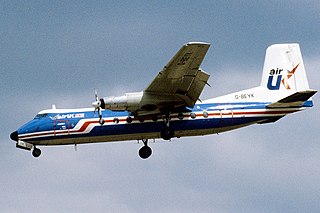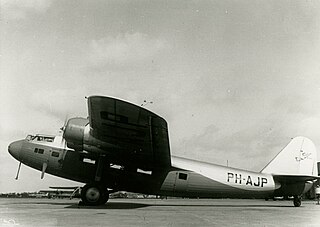
The Avro Canada C102 Jetliner was a Canadian prototype medium-range turbojet-powered jet airliner built by Avro Canada in 1949. It was beaten to the air by only 13 days by the de Havilland Comet, thereby becoming the second purpose-built jet airliner in the world, while both were preceded by the Nene Lancastrian, and the Nene Viking, both of which were conversions of piston engine airliners. The name "Jetliner" was chosen as a shortening of the term "jet airliner", a term which is still in popular usage. The aircraft was considered suitable for busy routes along the US eastern seaboard and garnered intense interest, notably from Howard Hughes who even offered to start production under license. However, continued delays in Avro Canada's all-weather interceptor project, the CF-100 Canuck, led to an order to stop working on the project in 1951, with the prototype Jetliner later cut up for scrap.

The Fokker F27 Friendship is a turboprop airliner developed and manufactured by the Dutch aircraft manufacturer Fokker. It is the most numerous post-war aircraft manufactured in the Netherlands; the F27 was also one of the most successful European airliners of its era.

The Fokker F28 Fellowship is a twin-engined, short-range jet airliner designed and built by Dutch aircraft manufacturer Fokker.

The Rolls-Royce RB.53 Dart is a turboprop engine designed and manufactured by Rolls-Royce Limited. First run in 1946, it powered the Vickers Viscount on its maiden flight in 1948. A flight on July 29 of that year, which carried 14 paying passengers between Northolt and Paris–Le Bourget Airport in a Dart-powered Viscount, was the first regularly scheduled airline flight by a turbine-powered aircraft. The Viscount was the first turboprop-powered aircraft to enter airline service - British European Airways (BEA) in 1953.

The Fokker 50 is a turboprop-powered airliner manufactured and supported by Dutch aircraft manufacturer Fokker. It was designed as an improved version of the successful Fokker F27 Friendship. The Fokker 60 is a stretched freighter version of the Fokker 50.

The Rolls-Royce RB.37 Derwent is a 1940s British centrifugal compressor turbojet engine, the second Rolls-Royce jet engine to enter production. It was an improved version of the Rolls-Royce Welland, which itself was a renamed version of Frank Whittle's Power Jets W.2B. Rolls-Royce inherited the Derwent design from Rover when they took over their jet engine development in 1943.

The Fokker 70 is a narrow-body, twin-engined, medium-range, turbofan regional airliner designed and produced by the now defunct Dutch aircraft manufacturer Fokker.

The Handley Page HPR.7 Dart Herald is a British turboprop passenger aircraft, designed in the 1950s as a DC-3 replacement, but only entering service in the 1960s by which time it faced stiff competition from Fokker and Avro. Sales were disappointing, contributing in part to the demise of Handley Page in 1970.

The VFW-Fokker 614 was a twin-engined jetliner designed and constructed by joint Dutch and West German aviation company VFW-Fokker. It is the first jet-powered passenger liner to be developed and produced in West Germany, as well as the first German-built civil aircraft to have been manufactured for a decade.

The Fokker S.14 Machtrainer is a two-seater military training jet aircraft designed and manufactured by the Dutch aircraft manufacturer Fokker for the Royal Netherlands Air Force (RNLAF). It has the distinction of being one of the first dedicated jet-powered training aircraft to be produced in the world.

The Fokker F.XXIV was a 1939 passenger airliner design by the Dutch aircraft manufacturer Fokker. It was Fokker's first all-metal airliner design.

The Fokker F.VIII was a large twin-engined airliner designed and produced by the Dutch aircraft manufacturer Fokker in the 1920s.

The Fokker F.IX was an airliner developed in the Netherlands in the late 1920s, intended to provide KLM with an aircraft suitable for regular services to the Dutch East Indies. When the onset of the Great Depression forced the postponement of those plans, the market for this aircraft disappeared as well, although it did see military service in Czechoslovakia as a bomber.

The Fokker F.XX was a 1930s Dutch three-engined airliner designed and built by Fokker. It was the first Fokker design to use an elliptical-section fuselage instead of the traditional square fuselage and the first Fokker aircraft with retractable landing gear.

The Fokker F.XXII was a 1930s Dutch four-engined 22-passenger airliner designed and built by Fokker.

The Fokker F.XXXVI was a 1930s Dutch four-engined 32-passenger airliner designed and built by Fokker. It was the largest transport designed and built by Fokker. Only one was built, and it was used for some commercial routes starting in 1935, and later aviation training by the British Royal Air Force until 1940.

The Fokker F.III was a single-engined high-winged monoplane aircraft produced in the 1920s by the Dutch aircraft manufacturer Fokker. It could carry five passengers. The aircraft was also built under licence in Germany as the Fokker-Grulich F.III.

The Fiat G.80 was a military jet trainer designed and produced by the Italian aircraft manufacturer Fiat. It has the distinction of being the first true jet-powered indigenous aircraft to be flown by Italy.

The Tupolev Tu-12 was an experimental Soviet jet-powered medium bomber developed from the successful piston-engined Tupolev Tu-2 bomber after the end of World War II. It was designed as an interim aircraft to familiarize Tupolev and the Soviet Air Forces (VVS) with the issues involved with jet-engined bombers.

The Fairchild 228 was a regional jet developed for the United States market by Fairchild Hiller using Fokker F28 sub-assemblies.



















